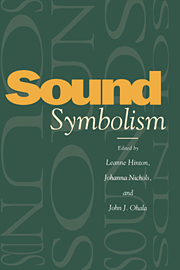Book contents
- Frontmatter
- Contents
- List of contributors
- 1 Introduction: Sound-symbolic processes
- PART I Native American languages north of Mexico
- PART II Native languages of Latin America
- PART III Asia
- 8 i: big, a: smal
- 9 Tone, intonation, and sound symbolism in Lahu: loading the syllable canon
- 10 An experimental investigation into phonetic symbolism as it relates to Mandarin Chinese
- 11 Palatalization in Japanese sound symbolism
- PART IV Australia and Africa
- PART V Europe
- PART VI English
- PART VII The biological bases of sound symbolism
- Index
8 - i: big, a: smal
Published online by Cambridge University Press: 04 August 2010
- Frontmatter
- Contents
- List of contributors
- 1 Introduction: Sound-symbolic processes
- PART I Native American languages north of Mexico
- PART II Native languages of Latin America
- PART III Asia
- 8 i: big, a: smal
- 9 Tone, intonation, and sound symbolism in Lahu: loading the syllable canon
- 10 An experimental investigation into phonetic symbolism as it relates to Mandarin Chinese
- 11 Palatalization in Japanese sound symbolism
- PART IV Australia and Africa
- PART V Europe
- PART VI English
- PART VII The biological bases of sound symbolism
- Index
Summary
Introduction
From the start, one must admit that the study of sound symbolism has a tarnished reputation in current linguistics. Among several reasons, the poor quality of the evidence is sufficient to explain why many theoreticians show a definite lack of interest in this topic.
Instances of sound symbolism found in languages like English tend to be limited in number, and scattered pell-mell through the language; the iconic patterns themselves are ill-structured, timidly developed, and often difficult to identify and describe. Nevertheless, the more uncertain the data the more daring the theories tend to become, and sober-minded linguists have good reasons to remain skeptical.
Among the more reasonable statements made about sound symbolism, it is often said (Sapir 1929; Newman 1933; Jespersen 1933; Tarte 1974) that if vowel quality is used for size symbolism, [i] will symbolize smallness, and the lower vowels, especially [a], will symbolize largeness, with degrees in between. Casual remarks are often made about this being another set of language “universals,” even though one major effort in this area (Ultan 1978) led only to guarded statements. Furthermore, there are suggestions (Ohala 1984) that this trait belongs not to the cultural but to the natural, innate domain.
This last point appears to be headed in the wrong direction, as I try to show below. Regarding the claim of universality, I will not have much to say, beyond deploring the incorrect use of the term “universal” to mean simply “found in a number of languages.” One learns to take such grandiloquent terminology for what it is. The real problem is in the first claim, the apparently reasonable one.
- Type
- Chapter
- Information
- Sound Symbolism , pp. 107 - 114Publisher: Cambridge University PressPrint publication year: 1995
- 10
- Cited by



